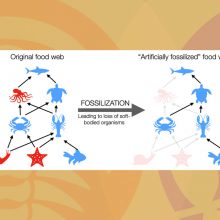
Photo from archive.org
Abstract. Interpreting the impact of climate change on vertebrates in the fossil record can be complicated by the effects of potential biotic drivers on morphological patterns observed in taxa. One… Click to show full abstract
Abstract. Interpreting the impact of climate change on vertebrates in the fossil record can be complicated by the effects of potential biotic drivers on morphological patterns observed in taxa. One promising area where this impact can be assessed is a high-resolution terrestrial record from the Bighorn Basin, Wyoming, that corresponds to the Paleocene–Eocene thermal maximum (PETM), a geologically rapid (∼170 kyr) interval of sustained temperature and aridity shifts about 56 Ma. The PETM has been extensively studied, but different lines of research have not yet been brought together to compare the timing of shifts in abiotic drivers that include temperature and aridity proxies and those of biotic drivers, measured through changes in floral and faunal assemblages, to the timing of morphological change within mammalian species lineages. We used a suite of morphometric tools to document morphological changes in molar crown morphology of three lineages of stem erinaceid eulipotyphlans. We then compared the timing of morphological change to that of both abiotic and other biotic records through the PETM. In all three species lineages, we failed to recover any significant changes in tooth crown shape or size within the PETM. These results contrast with those documented previously for lineages of medium-sized mammals, which show significant dwarfing within the PETM. Our results suggest that biotic drivers such as shifts in community composition may have also played an important role in shaping species-level patterns during this dynamic interval in Earth history.
Journal Title: Paleobiology
Year Published: 2021
Link to full text (if available)
Share on Social Media: Sign Up to like & get
recommendations!